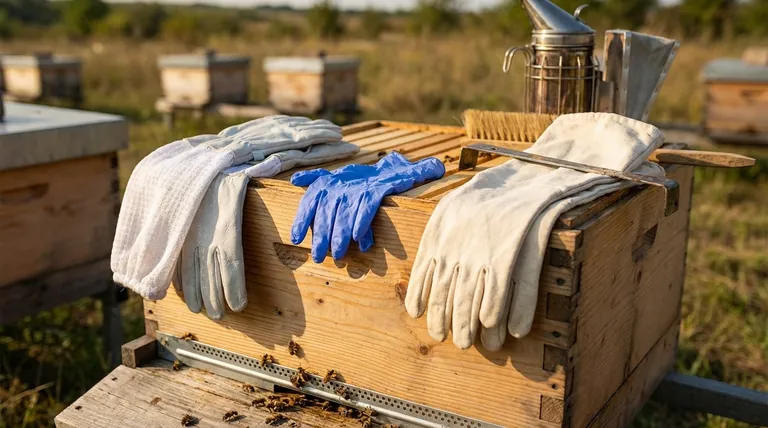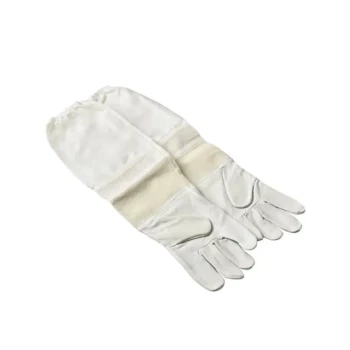When selecting beekeeping gloves, you have three primary material categories to consider: traditional leather, modern nitrile, and lightweight canvas or cotton. Each type is designed to balance the critical needs of sting protection and the dexterity required to work with your bees and equipment safely.
The core decision in choosing a beekeeping glove is managing the fundamental trade-off between maximum sting protection and maximum dexterity. No single glove perfects both, so your choice depends entirely on your priority.

A Closer Look at Glove Materials
Understanding the properties of each material is the first step in selecting the right tool for the job. Your comfort and confidence when handling bees will be directly impacted by this choice.
Leather Gloves (Goatskin): The Armor
Leather, particularly goatskin, is the traditional choice for beekeepers seeking the highest level of protection. Its thick, durable material provides a formidable barrier against bee stingers.
These gloves are a reliable option for beginners or anyone handling a particularly defensive hive. They build confidence by minimizing the risk of stings.
The primary drawback of leather is its lack of flexibility. The thickness that provides protection also reduces your ability to feel and perform delicate tasks, like marking a queen or handling small components.
Nitrile-Coated & Disposable Gloves: The Surgical Option
Nitrile gloves offer the highest level of dexterity, allowing you to feel what you are doing with near-bare-hand sensitivity. This makes them ideal for intricate hive work.
Many experienced beekeepers prefer nitrile gloves for their precise control. Cheaper, disposable nitrile gloves are also a viable option if you want to manage initial costs.
However, this dexterity comes at the cost of protection. While nitrile can provide some sting resistance, it is significantly less protective than leather and is not recommended for new beekeepers still learning to move calmly and deliberately.
Canvas & Cotton Gloves: The Lighter Alternative
Canvas or cotton gloves occupy a middle ground. They are generally more flexible than thick leather but offer more protection than thin nitrile.
These gloves are often ventilated and can be more comfortable in hot weather.
It is critical to ensure they are made of a thick, durable material. Thin cotton gloves are not sufficient for beekeeping, as they provide very little protection and can lead to frequent stings.
Understanding the Trade-offs
Choosing a glove isn't just about the material; it's about understanding the compromises you are making to suit your beekeeping style and comfort level.
Protection vs. Dexterity
This is the central conflict. A thick, protective glove like goatskin will prevent stings but make it harder to manipulate frames and tools.
A thin, flexible glove like nitrile allows for precise movements but increases the risk of a sting penetrating the material. Your choice reflects your personal balance between safety and control.
Durability and Longevity
Leather gloves are an investment. With proper care, a quality pair can last for several seasons, making them cost-effective in the long run.
Disposable nitrile gloves are designed for single or limited use. While the initial cost is low, the expense can add up over time.
Proper Fit and Coverage
Regardless of material, your gloves must fit snugly but not tightly. A loose glove can catch on equipment, while a tight glove restricts circulation and can stretch the material, making it easier for stingers to penetrate.
Ensure your gloves extend up to your elbows. This crucial feature protects your arms and allows you to layer your bee suit or jacket over the glove, creating a seal that prevents bees from crawling inside.
Making the Right Choice for Your Goal
Your experience level and the specific task at hand should guide your selection. Many beekeepers own multiple pairs of gloves for different situations.
- If your primary focus is maximum protection and confidence: Choose a durable pair of goatskin leather gloves.
- If your primary focus is dexterity for intricate tasks: A nitrile-coated or disposable nitrile glove is the superior choice.
- If you need a balance of breathability and moderate protection: Consider a pair of thick, well-made canvas gloves.
Ultimately, the right glove is the one that allows you to work calmly, confidently, and safely with your bees.
Summary Table:
| Glove Type | Best For | Key Feature | Main Drawback |
|---|---|---|---|
| Leather (Goatskin) | Maximum protection, beginners, defensive hives | Superior sting resistance and durability | Reduced dexterity and flexibility |
| Nitrile-Coated | Maximum dexterity, intricate tasks, experienced beekeepers | Near-bare-hand sensitivity and control | Lower sting protection |
| Canvas/Cotton | Moderate protection, hot weather, a balance of features | Breathable and more flexible than leather | Must be thick enough to be effective |
Equip Your Apiary with the Right Gloves from HONESTBEE
Choosing the correct gloves is fundamental to safe and efficient beekeeping. At HONESTBEE, we supply high-quality beekeeping gloves and equipment designed specifically for the demands of commercial apiaries and distributors.
We provide:
- Durable Protection: Long-lasting goatskin leather gloves for maximum sting resistance.
- Precision Control: Nitrile-coated gloves for beekeepers who prioritize dexterity.
- Wholesale Value: Competitive pricing and bulk options for your business.
Ensure your team works with confidence and safety. Contact our experts today to discuss your glove and equipment needs → Get in Touch
Visual Guide

Related Products
- Mesh Ventilated 3 Layer Goatskin Beekeepers Gloves for Beekeeping
- Goatskin Leather Beekeeper Gloves with Vent Long Sleeve for Beekeeping Honey Bee Sting Proof Protection
- Goat Skin Leather Bee Sting Proof Beekeeping Gloves with Canvas Sleeve
- Professional Drop-Style Hive Handles for Beekeeping
- HONESTBEE Professional Long Handled Hive Tool with Precision Cutting Blade
People Also Ask
- What should be considered when selecting beekeeping gloves? Find the Perfect Fit for Safety & Dexterity
- What factors should be considered when choosing beekeeping gloves? Balance Protection and Dexterity for Your Apiary
- Why is it important to have gloves available even if not always worn? Essential Risk Management for Beekeepers
- What is the role of gloves in beekeeping, especially for beginners? Build Confidence & Safety
- How do beekeeping gloves increase comfort during long sessions? Enhance Focus and Reduce Fatigue



















